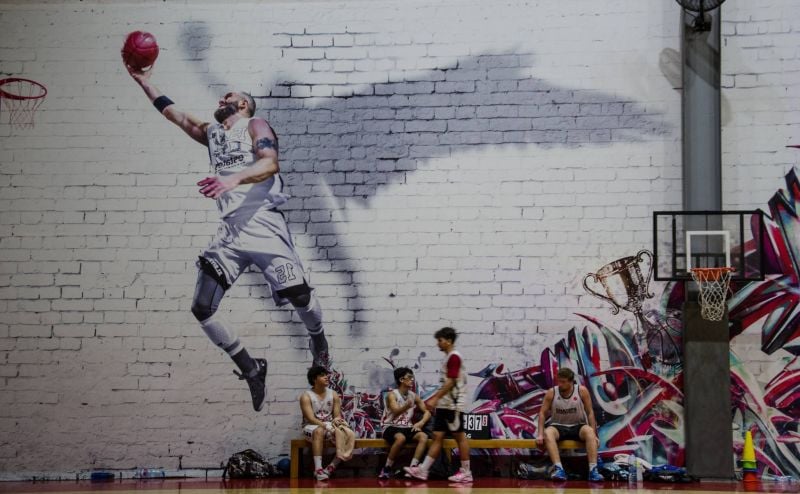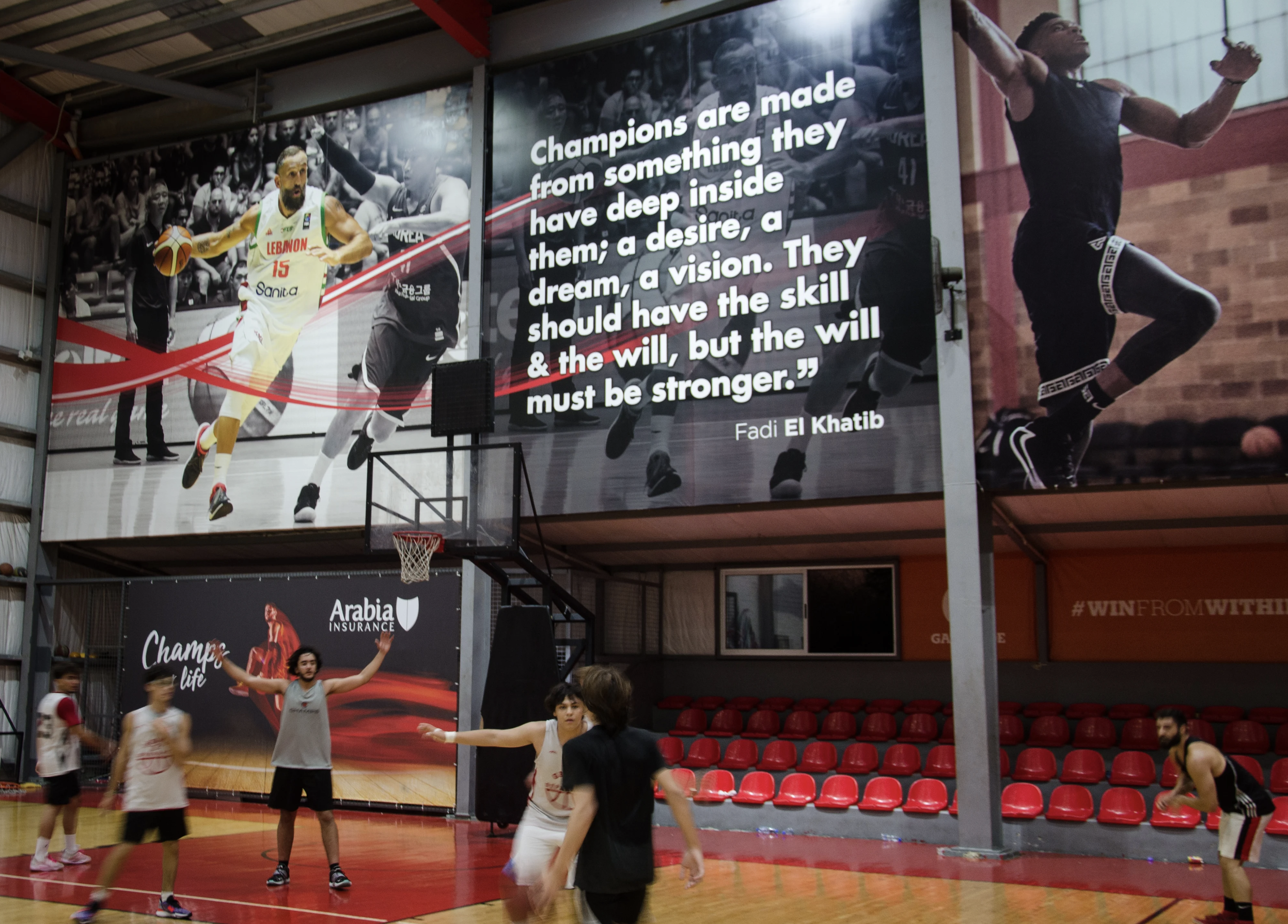
Mural showing Fadi el-Khatib about to score a basket above young basketball players training on the Champs Club basketball court in Hazmieh. (Credit: Emmanuel Haddad/L'Orient-Le Jour)
The wooden floor of the Champs basketball court in Hazmieh squeaks under the players’ shoes, soaked with sweat. Like a benevolent mentor, is a giant portrait of Fadi el-Khatib, also known as The Tiger, the historic captain of the Lebanese national basketball team and founder of this local sports club.
The Tiger, who retired a few months ago, will be watching from afar as his team defends Lebanon's colors in their first game against Latvia at the Basketball World Cup in Jakarta on Friday, after a 13-year absence.
Lebanon’s national team, which secured the runners-up spot in the FIFA Asia Cup last summer, “made us proud,” said 17-year-old Anthony Asmar. Inspired by their journey, he doesn’t take basketball lightly.
“It’s more than a sport, it’s a way of life— a priority,” Asmar said.
Next to him, Jadi al-Hani agrees. “At Champs, they tell us to concentrate on [our] school [studies], but we’d want to play at a professional level.”
These young players believe “basketball has a future” in Lebanon, and this is largely due to this sport’s glorious past.
 The basketball court in Champs sports center in Hazmieh. (Credit: Emmanuel Haddad/L'Orient-Le Jour)
The basketball court in Champs sports center in Hazmieh. (Credit: Emmanuel Haddad/L'Orient-Le Jour)
While footballers are the talk of the town all over the world, they lag far behind Fadi el-Khatib or Wael Arakji, the new star of the national basketball team, in terms of popularity. Arakji has become a prophet, enthroned on advertising billboards throughout the country.
But for The Cedars to qualify for the World Cup for the fourth time in their history, solid foundations — built to withstand the crises and tremors that shake Lebanon’s fragile balance and its sporting landscape — are needed.
‘Antoine Choueiri was a visionary’
The desire to give Lebanon a new national sport was born from the heap of ruins left by the 15-year-long Civil War. The place was left vacant by the collapse of the football championship, the most popular sport until 1975 by virtue of the French colonial heritage.
Basketball thus appeared on virtually virgin territory at a time, in the early 1990s, when almost everything had to be rebuilt.
In such a context, setting up an economically viable sports system was quite a challenge. But, as is often the case in Lebanon, such a project was made possible thanks to the determination of a small group of people, most notably Antoine Choueiri— the true architect of Lebanese basketball.
“He was a visionary,” said Ziad Joseph Rahal, a researcher at the University of Lille and author of several papers on sport in Lebanon. “He was more imaginative and open-minded than many others. He was the one who transformed Lebanese basketball and basketball players from the amateur to the professional level.”
‘Without him, there would have been no basketball in Lebanon’
A businessman known for building the Choueiri Group — the largest media empire in the Middle East at the time — Antoine Choueiri came to the forefront of the Lebanese sporting scene as president of the Achrafieh-based Sagesse football club. He then created the basketball department in 1992 and appointed Ghassan Sarkis as its head.
“If this man hadn’t existed, there would have been no basketball in Lebanon,” the famous coach said in 2022 on Tony Khalifeh’s LBCI talk show. “Without him, the national team and Lebanese clubs would never have been successful, and I wouldn’t be the Ghassan Sarkis I am today.”
It was also in 1992 that the first season of the national basketball championship was launched. In addition to the Sagesse and Riyadi teams, which were the driving forces, a host of other basketball teams were formed within the country’s universities and old sports clubs.
They included the Homenetmen, Hoops (Beirut and its suburbs), Antranik (Antelias), Champville (Metn), Tadamon, Notre-Dame de Louaize (Zouk Mosbeh), al-Mouttahed (Tripoli), Anibal (Zahle), Byblos. More than a dozen teams formed the first Lebanese professional basketball league, despite the then-rudimentary facilities and training methods.
“Before the inception of the Lebanese [Basketball] League, the players were still amateurs or semi-professionals. Everyone had a job during the day before coming to the training in the evening. It was only as of 1996 that players were paid enough to make a living from playing,” said Ziad Joseph Rahal. As a result, the number of members rose from 200 in 1992 to nearly 20,000 by 2020.
Basketball has also taken center stage for pragmatic reasons: “It’s much less complicated and costly to set up the infrastructure for basketball than it is to play football,” said Rahal.
“You don’t need to maintain a lawn, a small pitch is enough, and you only need five players to form a team, compared to 11 for football. Running a basketball club requires fewer financial resources, and this has facilitated the emergence of so many teams throughout Lebanon,” he said.
Substitute ground for sectarian clashes
The budgets of Lebanese basketball teams are all the tighter because they depend to a large extent on the budgets of the political parties to which they are closely or distantly linked.
“Basketball teams in Lebanon have followed the same politico-religious distribution as that imposed by the Constitution,” added Rahal.
In addition to their geographical specificity, sectarian affiliation also distinguishes these teams. Like everything else in Lebanon, with rare exceptions, the sporting fabric has been modeled on sectarian cleavages, inevitably giving each club a political color.
“The pioneers of basketball, including Antoine Choueiri, could not escape this logic that structures everything happening in Lebanese society. That’s why the political parties became overlapped in the basketball teams they financed to serve their interests, which were often much more electoral than sporting,” Rahal added.
According to this matrix, which is inseparable from Lebanon, the “derbys” between the league’s two champions, Sagesse (controlled by the Christian Lebanese Forces) against Riyadi (long-financed by Rafic Hariri’s Sunni Muslim Future Movement) have become much more than just basketball matches.
Although sporting rivalries are essential for the development and public attraction of a championship, these matches ended up becoming substitute grounds for sectarian standoffs that the 1989 Taif Agreement had not resolved.
As a result, until the late 2010s, these matches were regularly the scene of violent clashes between supporters, often requiring the intervention of the army.
However, a number of managers, including Antoine Choueiri and Hicham Jarroudi — former president of the Riyadi club and “the other pillar of Lebanese basketball,” according to Ghassan Sarkis —have tried to overcome divisions to change the dimension of these two tutelary clubs.
An ambition beyond Lebanon
The idea was to liberate the teams from sponsorships, which borders with clientelism, to diversify their sources of income and create an economic model that would ensure the long-term survival of the teams and their players.
“In the early 2000s, Choueiri wanted to set up an Arab league with Syria and Jordan, which agreed,” recounted Rahal.
“He felt that Lebanon had become too small for the quality of its basketball and that it was necessary to widen its scope to enable it to gain more visibility, thus attracting more sponsors and increasing revenue from broadcasting rights,” Rahal continued.
Although this project never saw the light, Sagesse and Riyadi nonetheless enjoyed success at the continental level, winning multiple Asian championships and Arab Cup titles at the turn of the millennium.
Then it was the national team’s turn to reap the rewards of this new emulation within the Lebanese League. The League has produced many talented players, including Fadi el-Khatib and Elie Mechantaf— the other member of the magical duo who took Sagesse to the top between 1998 and 2004, winning eight championships, three Lebanese Cups and three Asian Champion Clubs’ Cups.
Thanks to the talents of the expats, such as Paul Khoury, and some naturalized players, including American Joe Vogel, Les Cedres qualified for the World Cup finals three times in a row (2002, 2006 and 2010). They never made it past the first round, but did win a number of achievements, including beating France 74-73 in a 2006 game that will live long in the memory.
But this golden age was too good to last forever. After Antoine Choueiri withdrew from the sporting scene, fed up with the obstacles put in his path by some of his critics, Lebanese basketball began a slow decline in the late 2000s.
Abandoned, The Cedars were even suspended from all competitions by the International Basketball Federation (FIBA) for two years, from 2013 to 2014, due to unresolved conflicts within the Lebanese Federation.
After hitting rock bottom, the national team has finally resumed its growth trend thanks to a new generation of players and coaches — a generation that has enabled Lebanon to regain its place on the regional stage, where historically strong teams (Iran, Jordan, Egypt) are also in decline.
This takes nothing away from the merits of the team led by coach Jad el-Hajj, who led the national team to the fourth silver medal in their history at the 2022 FIBA Asia Cup, after losing 75-73 against Australia.
The other conductor of the orchestra, Wael Arakji, was even nominated the best Asian player, a first for Lebanon in nearly 20 years, after Fadi el-Khatib.
Above all, Lebanon has the chance to taste the thrill of a World Cup again after a 13-year hiatus and to thrill to cheer for a team with whom they can identify.
This article was originally published in French in L'Orient-Le Jour. Translation by Joelle El Khoury.